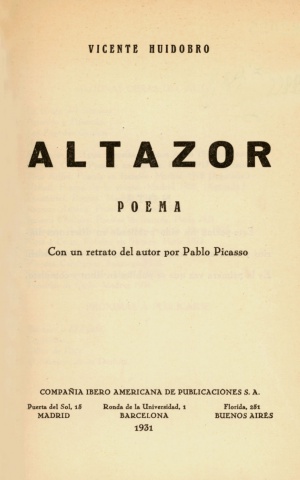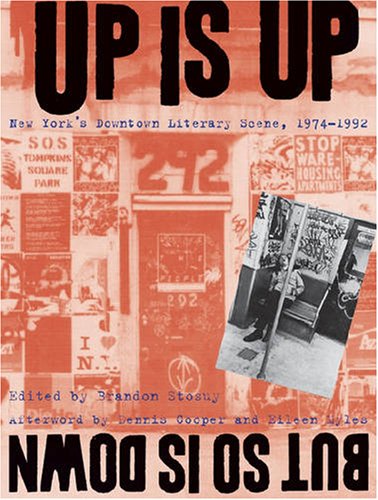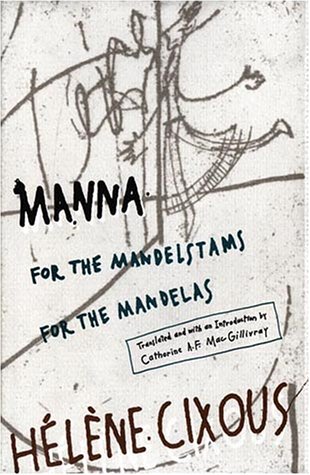Vicente Huidobro: Altazor, or, A Voyage in a Parachute/1919, a Poem in VII Cantos (1931–) [ES, EN]
Filed under fiction | Tags: · poetry

“The first modern poet of the Spanish language — in many ways its Apollinaire — Vicente Huidobro is generally considered to be one of the four greatest Spanish American poets of [the last] century. Yet unlike his peers — César Vallejo, Pablo Neruda, and Octavio Paz — Huidobro is still little-known in the English-speaking world.
Altazor, a book-length poem first published in 1931, is Huidobro’s masterpiece and one of the wildest poems of any language. The century’s great paean to flight, the poem sends its hero (Altazor, the antipoet) hurtling through Einsteinian space at light-speed, as all places and times collapse into one.” (from the back cover)
Publisher Compañia Ibero Americana de Publicaciones, Madrid/Barcelona/Buenos Aires, 1931
111 pages
Bilingual Spanish/English edition
Translated by Eliot Weinberger
Publisher Graywolf Press, Saint Paul, Minnesota, 1988
A Palabra Sur Book
ISBN 1555971067
167 pages
via filboid
Commentary: MemoriaChilena (ES), Justin Read (Translation Review, 2006, pp 61-65, EN), Mario Nandayapa (Liminar, 2006, ES), Bruce Dean Willis (Hispanic Issues, 2010, EN), Comparative analysis with Beckett’s Imagination Dead Imagine (Margaret Lees McTague, Master’s Thesis, 1976, EN).
PDF, PDF, HTML (Spanish, 1931, updated on 2020-12-6)
PDF (Spanish/English, 1988)
PDF, PDF (manuscript, Spanish)
Audio books (Spanish)
See also Altazor: de puño y letra (Spanish, ed. & with notes by Andrés Morales, 1999)
Brandon Stosuy (ed.): Up Is Up, But So Is Down: New York’s Downtown Literary Scene, 1974-1992 (2006)
Filed under book | Tags: · 1970s, 1980s, 1990s, art, diy, history of literature, literature, music, new york, poetry, publishing, theatre

“Sometime after Andy Warhol’s heyday but before Soho became a tourist trap, a group of poets, punk rockers, guerilla journalists, graffiti artists, writers, and activists transformed lower Manhattan into an artistic scene so diverse it became known simply as “Downtown.“ Willfully unpolished and subversively intelligent, figures such as Spalding Gray, Kathy Acker, Richard Hell, David Wojnarowicz, Lynne Tillman, Miguel Piñero, and Eric Bogosian broke free from mainstream publishing to produce a flood of fiction, poetry, experimental theater, art, and music that breathed the life of the street.
The first book to capture the spontaneity of the Downtown literary scene, Up Is Up, But So Is Down collects more than 125 images and over 80 texts that encompass the most vital work produced between 1974 and 1992. Reflecting the unconventional genres that marked this period, the book includes flyers, zines, newsprint weeklies, book covers, and photographs of people and the city, many of them here made available to readers outside the scene for the first time. The book’s striking and quirky design—complete with 2-color interior—brings each of these unique documents and images to life.
Brandon Stosuy arranges this hugely varied material chronologically to illustrate the dynamic views at play. He takes us from poetry readings in Alphabet City to happenings at Darinka, a Lower East Side apartment and performance space, to the St. Mark’s Bookshop, unofficial crossroads of the counterculture, where home-printed copies of the latest zines were sold in Ziploc bags. Often attacking the bourgeois irony epitomized by the New Yorker’s short fiction, Downtown writers played ebulliently with form and content, sex and language, producing work that depicted the underbelly of real life.
With an afterword by Downtown icons Dennis Cooper and Eileen Myles, Up Is Up, But So Is Down gathers almost twenty years of New York City’s smartest and most explosive—as well as hard to find—writing, providing an indispensable archive of one of the most exciting artistic scenes in U.S. history.”
With an afterword by Dennis Cooper and Eileen Myles
Publisher NYU Press, 2006
ISBN 9780814740118
500 pages
Downtown Collection at NYU’s Fales Library
Reviews: Ed Halter (Village Voice, 2006), Meghan O’Rourke (New York Times, 2006), Tim W. Brown (Columbia Journal of American Studies, n.d).
Commentary: Cynthia Carr (New York Times, 2006), Peter Cherches (2006).
PDF (39 MB, updated on 2019-8-23)
Comments (2)Hélène Cixous: Manna: For the Mandelstams for the Mandelas (1988/1994)
Filed under book | Tags: · biography, language, literature, poetry, politics, resistance

“They didn’t know each other, but they knew the same suffering.
A Russian Jewish poet who died in exile in Siberia; a South African political leader who survived his banishment to prison: The two men, Osip Mandelstam and Nelson Mandela, so far apart in time and space, are brought together in this story, their shared destinies unraveled in light of the Jewish and African diasporas.
In Manna, Hélène Cixous, a writer associated with the notion of écriture féminine and a major figure in Continental feminist practice during the 1970s and early 1980s, continues her disruption of the orthodoxies of politics and social order through the liberating use of poetic language. In this act of willful writing, by turns lyrical and intense, she links her two distant subjects through the common first syllables of their names, the dates of their respective exiles, and the women, Nadezhda Mandelstam and Winnie-Zami Mandela, who disclose and restore their partners’ lives through language.
For Cixous, politics is approached most openly and freely through poetry; no social change occurs without linguistic change. In Manna her poetic language mediates the historical, political, and personal narratives of Mandelstam and Mandela (two cores lodged in the heart of the world) to produce a new sense of individual tragedy and cultural possibility. An act of emancipation, exhilarating in the way it subverts the master texts of social and political power, this strange and beautiful book releases its subjects-and its readers-from the limited language of constraint and exile.”
First published as Manne aux Mandelstams aux Mandelas, Les Editions des Femmes. Paris, 1988.
Translated and with an Introduction by Catherine A. F. MacGillivray
Publisher University of Minnesota Press, 1994
ISBN 0816621144, 9780816621149
294 pages
via leninbert
Review: Clare Cavanagh (Slavic Review, 1997).
Comment (0)
